For their immense medical benefits, compression socks and stockings are popular among people suffering from problems in their lower limbs and veins. If you happen to go to any medical or rehab facilities, you would surely come across a lot of people that are wearing them. However, not all the compression stockings are the same, and that’s where things get a little confusing. While compression techniques in stockings are being used for ages now, the masses still don’t quite know which type is the right kind for them.

From the outset, both compression stockings and anti-embolism stockings are made using the same technique. They are both support hosiery made using highly beneficial compression techniques. What it means is that both of these stockings use age-old techniques to affect the blood circulation in your limbs and veins. Thus, they are capable of offering a number of medical and health benefits.
Yet, they are not quite the same. Both compression stockings and anti-embolism stockings have different purposes. Due to their compression levels, it is also important to choose the right level and form of compressions in your preferred stockings. Having considered all of these elements, below we discuss the difference between compression stockings and anti-embolism stockings.
The Definition: What Are They
In terms of definition, compression stockings and anti-embolism stockings are pretty much the same things, except for their different zones of strongest tightening. While there isn’t much difference in there, it still good to know what they are, before going into the details of their differences.

Compression Stockings
Compression stockings are special hosiery made using elastic materials to be worn on legs. Pretty similar looking to normal pantyhose, these stockings are stretchy and tight-fitting. Once worn, they feel tightest around the ankles, with the compressions gradually decreasing as it rolls open towards the knees.
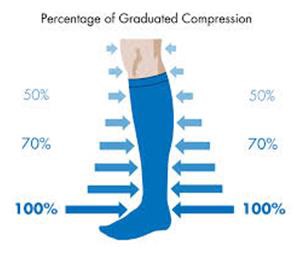
Anti-Embolism Stockings
Known also as TED hose or thrombo-embolic deterrent hose, anti-embolism stockings are also made using elastic materials and comes with compression techniques. However, they are designed to provide the highest amount of pressure around the calf area.
Compression Stockings vs Anti-Embolism Stockings
As you can see from the definition, compression stockings and anti-embolism stockings are different right from the way they are designed. Therefore, it is pretty obvious that they would be different in terms of their purpose, the level of compressions used, the people who can benefit from wearing them, and so on. Let’s compare them against each other in terms of their different functionalities and everything else to find out the difference below:
How Anti-embolism Stockings and Compression Stockings are Made?
Despite using almost similar materials and techniques, it’s the level of compressions and the way they are graduated all across the garment that primarily makes these stockings different from each other.
Compression Stockings
In the main, compression stockings are tightest and exert the most amount of pressure around the calves. It is where the gravitational force is the strongest while standing. They also exert compressional pressures around the calves, but gradually decreases around the knees and thigs.
The level of compressions uses in this particular type of garments also varies with a range of 15-20mmHg, 20-30mmHg, and 30-40mmHg. To resolve a unique health condition in a particular patient, compressions stockings can be custom made with up to 60mmHg levels of compressions.
Anti-Embolism Stockings
Ted hose or anti-embolism stockings, on the other hand, feels the tightest at and around the ankles, with different level of graduated pressure pattern is also found at and around the ankle, calf, lower thigh, upper thigh, and popliteal.
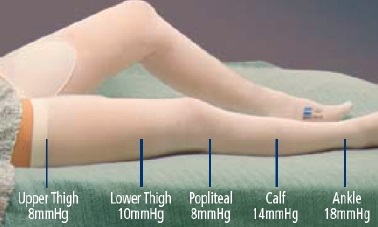
When it comes to the level of compressions used, the difference of it from compression stockings gets starkly clear. Anti-embolism stockings must be made with a compression level of a maximum of 20mmHg or lower. The most typical level of compressions in TED hose ranges between 8 – 18 mmHg.
Popular Articles on ComproGear
Plus Size Compression Socks 3XL Compression Socks
Best Compression Socks for Ankle Swelling Used These During My Diet To Stop Edema
Best Compression Socks for Elderly Zipper Compression Socks for Seniors
Compression Socks for Nurses Compression Stocking Pressure Guide
Different Functionalities of Compression Stockings and TED Hose
Compression Stockings are made with a view to providing pressure in certain areas of the lower extremities to increase the blood flow. They are also designed to reduce the diameter of the distended veins and force blood to pass through the narrower channels. By doing so, they reduce the chance of blood pooling in the feet.
The main functions of anti-embolism stockings are to prevent the adverse effects of venous distension during surgery. By providing comfortable pressure in different areas of lower extremities, these particular stockings ensure the blood doesn’t get pooled in both legs.
For Whom, These Stockings are Made for?
When it comes to the people for whom these two types of stockings are made, there are significant differences between anti-embolism stockings or TED hose and compression stockings.
TEDs (Anti-embolism stockings) are for Beds
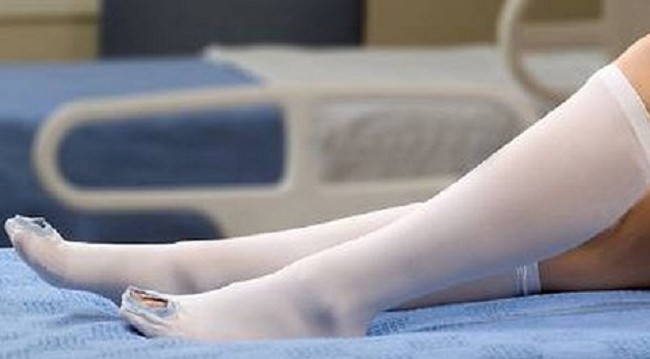
To be frank, TED hose are made for people who are can’t move around, run or walk; and thus, are pretty much confined to their beds. They are also used immediately after surgery to help prevent blood pooling in the legs and leading to blood clots.
Caution: Due to their different points of compressions, the legs of each wearer must be measured correctly for a perfect fit. Otherwise, the pressure points may not be able to exert pressure and cause the intended benefits.
Compression Stockings are for Walking
Compression stockings, on the other hand, are made for ambulatory patients who can walk or run but suffer from problems caused by irregular blood circulation. They provide a more aggressive level of compression and must be used by mobile people because, without the movement of the legs, it is difficult for blood to recirculate in the lower extremities through the pressured channels.
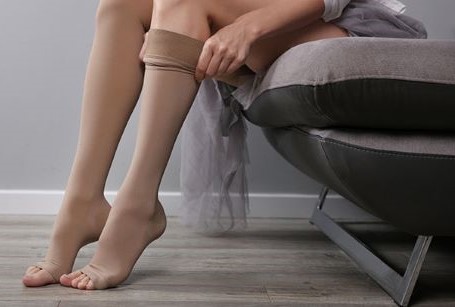
Below is a list of people who can benefit from wearing compression stockings:
- People who stand all day or over a long shift at work.
- People who spend a lot of time flying on an airplane.
- Athletes and Pregnant Women.
- People who find it unusually stressful to move around or getting up from bed in the morning.
Caution: However, if you are planning to use compression stockings, it is advised to discuss the issues with certified professionals. In fact, compression stockings with more than 20mmHg levels of compressions usually need to be ordered by a physician as they are deemed to be prescription-grade.
Different Medical benefits of Compression Stockings and Anti-embolism Stockings
Due to being a different type of garment with different levels and patterns of compressions, the medical benefits of wearing each of the stockings are also different. With a significantly varying degree of compressions, compression stockings are usually used for a greater number of medical purposes than the Anti-embolism stockings.
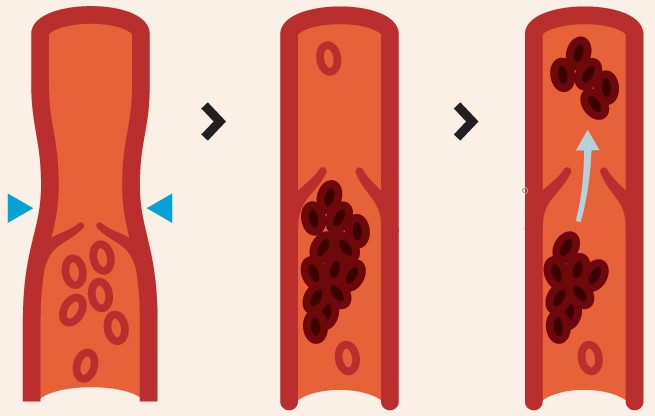
Benefits of Compression Stockings
Compression stockings are usually prescribed for patients with venous insufficiency, edema, lymphedema, and varicose veins. These stockings are also useful for people suffering from chronic peripheral venous insufficiency, lipodermatosclerosis, phlebitis, etc.
In general, as compression stockings increase and regulate blood circulation in the lower extremities, they can reduce leg stress and fatigue. They also prevent leg muscles from swelling.
Benefits of Anti-embolism Stockings
With the key purpose of normalizing venous return in a bedridden patient, TED Hose or Thrombo-Embolic Deterrent Hose are prescribed for the post-surgical patients. They can also be worn by people who are immobile or are bound to a wheelchair until they can walk freely on their own.

These stockings are also prescribed for patients with a history of venous thromboembolism (VTE), as well as patients with cancer f cancer that makes them extremely vulnerable to VTE.
Different Durations of Use
First of all, the duration of use and the longevity of each particular type of stockings vary from person to person, depending on their medical and health conditions. However, they are different, general lengths of use, which are:
- Duration of Compression Stockings: In general, compression stockings are designed to last for around 6 months, and can be worn until they wear out. Of course, you should consult with a doctor for a recommendation suitable for your particular needs.
- Duration of Anti-Embolism Stockings: Anti-embolism stockings, on the contrary, are designed for short-term uses and usually last for around 3 weeks. The reason is that the patients usually get mobilized within this time. For particular cases, doctors may recommend to wear them for a little longer.
How to Spot the Differences with Naked Eye
With so many differences hidden in the details like elasticity, compression levels, and purposes; you may be wondering about a way to spot it at first sight. Fortunately, there are some significant design differences between compression stockings and anti-embolism stockings that make it easy not to confuse them with each other.
Design of Compression Stockings

As mentioned before, compression stockings are designed to look pretty similar to any other pantyhose. They cover the entire feet and rolls up and over the thighs. The similarities with pantyhose continue in terms of appearances, with compression stockings available in various different designs and color options.
Design of Anti-Embolism Stockings
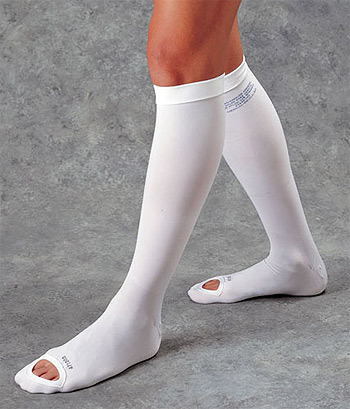
On the other hand, anti-embolism stockings look like a medical stocking right at first glance. Usually, they are only available in the color white. Unlike compression stockings, TED hose also comes with a hole around the toes in order to facilitate the monitoring of the blood circulatory status of the patients.
Importance of Using the Right Stockings
Compression stockings depend largely on its ability to exert pressure on the right places of lower extremities. Therefore, it might have some medical ramifications, if not wearing the appropriate stockings. Instead of regulating the blood circulation towards the lower part of the body, wrongly chosen stockings may affect the blood pressures in the wrong places.
As the compression levels vary significantly between anti-embolism stockings and compression stockings, the former must be chosen for post-surgical conditions. Compression stockings in itself offer different levels of pressure for different purposes, so, need some careful investigations before purchase.
Final Words
While both of these garments are the results of similar compression techniques, they are very different in pretty much everything else – compression levels, pressure points, purpose, benefits, design, and color, etc.
Compression stockings fulfill a great range of purposes that include relaxing the venous muscles, increasing the blood circulations in the lower extremities, as well as helping to remedy specific medical conditions.
Anti-embolism stockings, on the other hand, are suitable for immobile patients to reduce the symptoms of venous thromboembolism (VTE) and regulate the blood circulations.
This page last updated July 26, 2022
